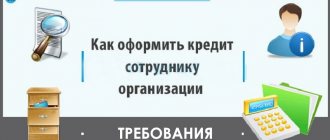Russian legislation allows the parties to a transaction to include in the loan agreement a condition that it is interest-free. In this situation, you need to consider the tax consequences of an interest-free loan.
Dear readers! The article talks about typical ways to resolve legal issues, but each case is individual. If you want to find out how to solve your particular problem , contact a consultant:
8 (800) 700 95 53
APPLICATIONS AND CALLS ARE ACCEPTED 24/7 and 7 days a week.
It's fast and FREE !
Everyone knows what a loan is. Almost everyone has taken out a loan at least once and knows the conditions for applying for it. The parties to the transaction can enter into a gratuitous loan.
Entrepreneurs often use this technique to distribute funds between partners. Exactly the same agreements are signed by business entities.
But before concluding this agreement, you should familiarize yourself with all the nuances of the procedure.
Is it possible to lend without interest?
Civil legislation does not contain a ban on providing interest-free loans. Moreover, the lender has the right to receive interest from the borrower on the loan amount, unless otherwise provided by the agreement (Part 1 of Article 809 of the Civil Code of the Russian Federation). That is, when issuing an interest-free loan, this must be provided for in the contract. If there is no such clause, then by default the loan agreement is considered interest-bearing. In this case, interest is determined based on the key rate of the Central Bank of the Russian Federation, which is applied instead of the refinancing rate from January 1, 2021.
Receiving funds
To receive a loan, any person must fill out an application indicating the amount and expected repayment period. Based on this document, the lender makes a decision.
The loan agreement is drawn up on the basis of the passport of a person who is one of the parties to the transaction or the passport of a representative of the organization.
For a legal entity, the full name of the organization and its details (location address, bank account details, etc.) are additionally indicated.
Companies primarily receive loans to their current account. The loan amount must be reflected in the company’s accounting department.
Individuals, including individual entrepreneurs, can independently choose the method of transferring borrowed money.
The most popular of them include:
- crediting money to the borrower's account or to his bank card;
- it is possible to obtain a loan in cash at the lender’s cash desk;
- microfinance companies practice loan transfer methods such as transfer to an electronic wallet or through the Contact system.
If the loan amount is large enough, it can be transferred in parts. To do this, a loan schedule is drawn up, which is an appendix to the main document.
Borrower - organization
The question that worries organizations is: do they generate income in the form of material benefits when receiving “free” loans? For example, with a gratuitous lease, the user of the property must reflect non-operating income based on the market value of the lease. Doesn't a similar procedure apply when receiving interest-free loans?
No, it does not apply. When calculating income tax, organizations take into account income from sales and non-operating income (clause 1 of Article 248 of the Tax Code of the Russian Federation). In the list of non-operating income given in Article 250 of the Tax Code of the Russian Federation, the material benefit received by the organization from the interest-free use of borrowed funds is not named. Of course, this list is not closed, but in order for the amount of benefit to correspond to income, it is necessary that the possibility of its assessment be provided for in Chapter 25 of the Tax Code of the Russian Federation (Article 41 of the Tax Code of the Russian Federation). And Chapter 25 of the Tax Code of the Russian Federation does not contain a procedure for assessing income in the case under consideration.
This is also confirmed by officials, as evidenced, for example, by letters from the Ministry of Finance of Russia dated March 23, 2017 No. 03-03-RZ/16846, dated February 9, 2015 No. 03-03-06/1/5149.
Cheat sheet on the article from the editors of BUKH.1S for those who do not have time
1.
Civil legislation does not contain a ban on providing interest-free loans. But the fact that the loan is interest-free must be noted, since by default the loan agreement is considered interest-bearing.
2.
Organizations do not generate income in the form of material benefits when receiving “free” loans.
3. When receiving an interest-free loan, an individual borrower may
income arises in the form of material benefits from savings on interest, subject to personal income tax.
4. For a borrower who is an individual entrepreneur using the OSNO, simplified tax system and unified agricultural tax, income in the form of material benefits from savings on interest is subject to personal income tax.
5. With individual entrepreneurs using PSN or UTII, the situation is as follows: tax authorities and courts do not agree that when using an interest-free loan for business purposes, the obligation to tax personal income tax does not arise for material benefits from saving on interest. You will still have to pay tax.
Features of loans
Many people believe that the concepts of loans and credits are synonymous. But this is completely wrong. A credit agreement is only one type of loan agreement. It is necessarily interest-bearing and can only be concluded with a bank or other legal entity that has received the appropriate license.
The concept of a loan is much broader. Let's look at the main features of loans :
Dear readers! The article talks about typical ways to resolve legal issues, but each case is individual. If you want to find out how to solve your particular problem , contact a consultant:
8 (800) 700 95 53
APPLICATIONS AND CALLS ARE ACCEPTED 24/7 and 7 days a week.
It's fast and FREE !
- a loan can be provided not only with money, but also with things;
- the possibility of concluding a contract free of charge;
- the agreement is considered concluded at the moment of transfer of money or other property.
The loan can be issued by any legal entity or individual. In most cases, it is issued in cash, but according to the law it can also be provided in things. At the same time, it is important that they are united by generic characteristics and do not have individual properties that allow them to be distinguished.
For example, it is impossible to issue a loan with a car that has a certain license plate, but with sheet metal of a certain brand it is quite possible.
By default, loans issued by goods are considered interest-free. With cash loans the situation is completely opposite. They will be considered issued free of charge only in a situation where the contract explicitly contains this condition.
Otherwise, interest will be charged; if its amount is not specified, the refinancing rate will be used. This must be taken into account when concluding contracts.
The loan agreement is considered concluded when it is signed and contains an obligation for the lender to issue a loan. The loan agreement will be considered concluded only after the transfer of the property specified in it, regardless of whether the loan is monetary or provided in goods.
Important! Any individuals and legal entities can receive and issue loans. It is not necessary to be affiliated or have family ties. It should be borne in mind that regular issuance of loans may raise questions from regulatory authorities.
Borrower – individual
If the borrower is not a company, but an individual (for example, an employee of the lending organization), then he may have income in the form of material benefits from savings on interest, subject to personal income tax. Why can it? Yes, because it all depends on the purpose for which the loan is issued. If a loan is issued for the purchase (construction) of housing or land, then provided that the tax inspectorate confirms the right of the citizen-borrower to use the property tax deduction, the material benefit is exempt from taxation (paragraph 5, paragraph 1, paragraph 1, Article 212 of the Tax Code of the Russian Federation ).
Since when issuing an interest-free loan to a citizen, personal income tax is paid by the lending organization as a tax agent, it is to it that the “physician” must provide the appropriate confirmation. A document confirming the right to a property tax deduction may be:
- notification in the form approved by order of the Federal Tax Service of Russia dated January 14, 2015 No. ММВ-7-11/3, issued by the tax office for submission to the employer (tax agent);
- a certificate in the form given in letter No. BS-4-11/329 dated January 15, 2016, which can be issued by the tax office for presentation to other tax agents (other than employers).
In this case, the document must contain details of the loan agreement, on the basis of which the funds spent on the purchase of real estate, in respect of which a property deduction was provided, were provided. In the absence of relevant details, such a document cannot be the basis for tax exemption. This conclusion was made, in particular, in the letter of the Ministry of Finance of the Russian Federation dated September 21, 2016 No. 03-04-07/55231. It also states that a one-time submission of a supporting document is sufficient, that is, it is not necessary to submit a notification (certificate) annually in order to be exempt from personal income tax in subsequent years when repaying the issued loan.
But if the supporting document is issued not to the borrower directly, but to the spouse, then the exemption from personal income tax can no longer be applied. Officials from the Federal Tax Service of Russia drew attention to this in their letter dated June 23, 2016 No. BS-4-11/1120.
Now let’s talk about how to determine income in the form of material benefits from saving on interest. From 2021, such income is determined on the last day of each month in which the loan (credit) agreement was valid, regardless of the date of receipt of such a loan (clause 7, clause 1, article 223 of the Tax Code of the Russian Federation). The income itself is calculated based on 2/3 of the Bank of Russia refinancing rate established on the date of receipt of income (clause 1, clause 2, article 212 of the Tax Code of the Russian Federation). In this case, personal income tax is calculated at a rate of 35 percent (clause 2 of Article 224 of the Tax Code of the Russian Federation).
If the borrower has cash income from which tax can be withheld (for example, salary), then no questions arise. If there is no such income, for example, if the loan was issued to a citizen who is not an employee, then there is no way to withhold tax. This means that the lender is limited to submitting a message to the Federal Tax Service about the impossibility of withholding tax. The message is submitted in the form of a 2-NDFL certificate indicating code “2” in the “Sign” field. In this case, the procedure for filling out a certificate with attribute “2” is similar to the procedure for filling out a certificate with attribute “1”. However, in section 3 “Income taxed at the rate of __%” you need to indicate only those incomes from which tax was not withheld.
In what cases can you not pay tax?
A legal entity can get rid of the obligation to pay tax on a non-repaid loan in the following ways:
- By mutual agreement, set a deadline for repaying the debt amount.
- After the expiration of the period allotted for repayment of the loan, as well as when the statute of limitations expires, the borrower must send a document. It states that the borrower acknowledges the debt and undertakes to repay it within a certain time frame.
- It is necessary to pay attention to the fact that the letter must be formatted and sent according to certain rules. It must be sent by mail with acknowledgment of receipt. You can also make a copy of the document for yourself and get a note from the creditor that he has a copy of the letter and has read its contents.
When applying for a gratuitous loan between two legal entities, certain difficulties may arise. The difficulty is most often associated with the fact that in order to be exempt from paying taxes, the parties must provide substantial evidence that the concluded agreement does not contain signs of a financial service.
In practice, this is not always possible. Therefore, some lawyers consider a scheme where a loan is issued at a small interest rate to be a more acceptable option. However, you need to understand that in this case the lender’s profit will be subject to a 20 percent tax.
Interest-free loan repayment
Possible methods of loan repayment are determined by the agreement or company rules (applicable to banks and microfinance organizations). A loan issued by a legal entity is primarily repaid by transferring funds to a current account.
To carry out the operation you can use:
- banks;
- ATMs;
- payment terminals.
In some cases, it is possible to deposit funds to pay for the loan to the company's cash desk.
Loans from individuals can be repaid:
- in cash, using a personal meeting or existing money transfer systems;
- by crediting funds to a person’s card or bank account;
- transfer to an electronic wallet.
If the loan agreement does not provide for a method of debt repayment, the borrower can independently choose the most suitable method for himself.
Any loan agreement provides for penalties for late repayment of the debt. An interest-free loan is no exception.
If the borrower does not pay the debt on time, the loan automatically becomes interest-bearing, but it is accrued only after the repayment period has expired.









